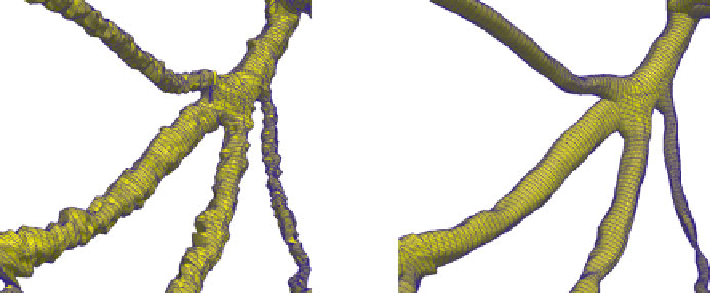Biomedical Engineering Reference
In-Depth Information
Fig. 10.1
Details of a multi-branched artery as obtained from MDCT (
left
) and after smoothing
have been applied as used in simulations (
right
)
When studying coronary arteries as a prototypical system for plaque formation
and development, one issue regards the inclusion of deformable vessels in simula-
tion. Whereas larger arteries undergo high deformations, a simple calculation
shows that the distensibility index of a coronary artery of sectional area
A
is
b
1
1. 5 mmHg. Therefore, the arterial section during a heartbeat has a maxi-
mal deformation of
dA
'
P
, with
DP
the maximal pressure variation over a
cardiac cycle. For a pressure jump of 40 mmHg, the deformation is less than 3%,
and considering rigid coronary systems does not introduce major artifacts in the
computed flow and pressure distributions.
LB allows to impose no-slip boundary conditions at the endothelium by
employing the bounce-back method; this consists of reversing at every time step
the post-collisional populations pointing toward a wall node, providing first-order
accuracy for irregular walls [
41
]. In the bounce-back method, the points
corresponding to the exact no-slip hydrodynamic surface fall at intermediate
positions between the external fluid mesh nodes and the nearby wall mesh nodes.
Owing to its simplicity, the method handles irregular vessel boundaries in a
seamless way, although more sophisticated alternatives with higher-order accuracy
are available [
4
,
21
,
17
].
In a branched portion of arteries, boundary conditions at the inlet and multiple
outlets can be chosen in different ways, typically by following the flow-pressure,
pressure-pressure, or flow-flow prescriptions. The first two options are more popu-
lar in fluid-dynamic models, and pressure conditions at the outlets reflect the
presence of a recipient medium. Even flow-flow conditions have found some
applicability, as they can accommodate some type of metabolic autoregulation as
encoded by Murray's law [
40
]. It is worth mentioning that flow-flow conditions can
give rise to numerical instabilities in simple pipe flows, as long-lived transients can
develop and a certain strain is exhorted on the simulation method. The absence of a
peripheral system in real-life simulations can be compensated by using an equiva-
lent RCL circuit at each system outlet, where the auxiliary circuitry introduces an
=
A
¼
b
D

Search WWH ::

Custom Search